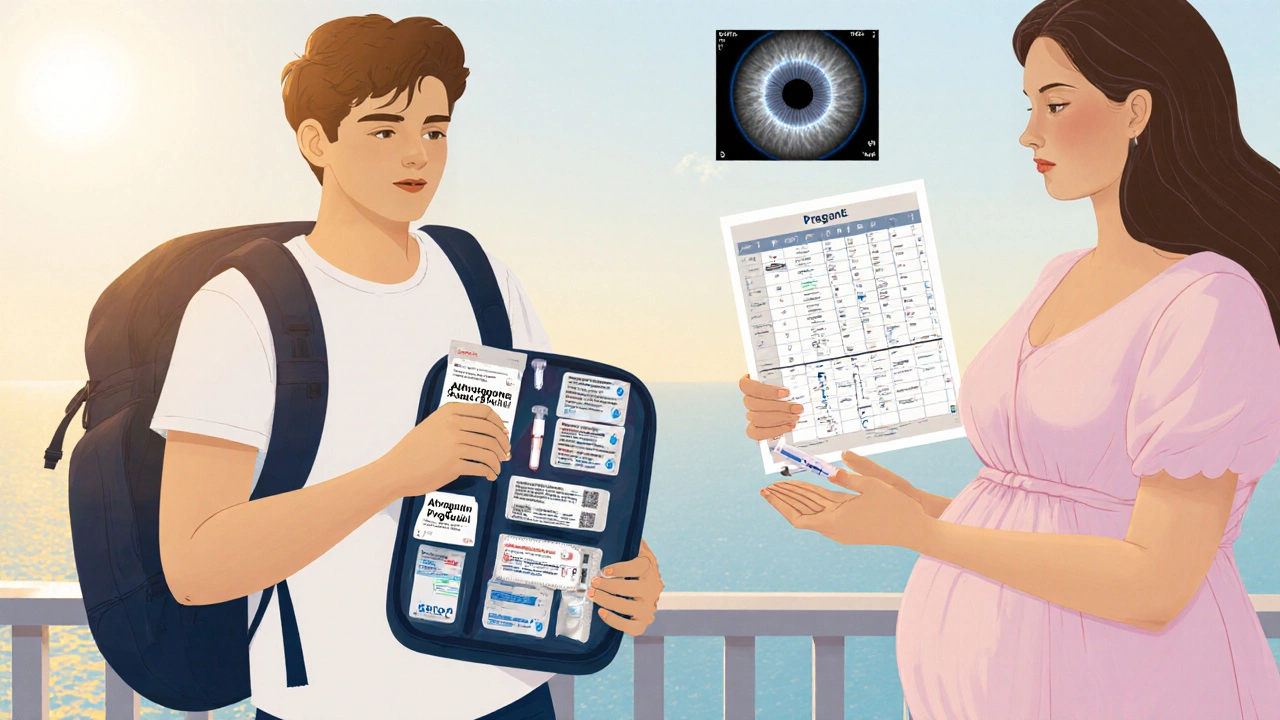Chloroquine vs. Alternatives: A Practical Comparison
 Oct, 14 2025
Oct, 14 2025
Malaria Drug Selection Assistant
Find Your Best Antimalarial Option
Recommended Options
When you need to treat malaria-or manage autoimmune conditions like lupus-picking the right drug can feel like a gamble. Chloroquine is a synthetic antimalarial that blocks the parasite’s ability to break down hemoglobin, stopping infection in its tracks. But resistance, side‑effects, and pregnancy safety often push doctors and patients to look for chloroquine alternatives. Below you’ll find a straight‑to‑the‑point guide that lets you weigh the pros and cons of the most common substitutes.
Key Takeaways
- Chloroquine works well in areas with low resistance but can cause retinal toxicity on long‑term use.
- Hydroxychloroquine offers a better safety profile for autoimmune disease but shares much of chloroquine’s resistance patterns.
- Mefloquine, artemisinin‑based combos, and atovaquone‑proguanil are the go‑to options for resistant malaria strains.
- Pregnant patients should avoid most quinoline drugs; primaquine and tafenoquine require G6PD testing.
- Side‑effect management (headache, nausea, neuro‑psychiatric symptoms) often determines which drug you’ll actually stick with.
How We Compare Drugs
To keep the comparison useful, we focus on five real‑world criteria:
- Mechanism of action - how the drug kills the parasite.
- Primary indications - malaria vs. autoimmune use.
- Dosing & half‑life - convenience and duration of protection.
- Safety profile - common and serious adverse events.
- Resistance & pregnancy considerations - where the drug can’t be used safely.
Chloroquine: The Baseline
First approved in the 1940s, Chloroquine is a 4‑aminoquinoline that accumulates in the parasite’s digestive vacuole, raising pH and preventing heme detoxification. Typical adult dosing for uncomplicated *Plasmodium falciparum* infection is 600mg base (about 1g of chloroquine phosphate) on day 1, followed by 300mg on days 2 and 3. Its half‑life is roughly 1-2weeks, which means a single course can linger in the body for weeks.
Side‑effects are dose‑dependent: mild nausea, headaches, and dizziness are common, while rare but serious retinal toxicity can develop after months of high‑dose therapy. Because resistance swept through sub‑Saharan Africa in the 1990s, chloroquine is now mostly limited to South‑East Asia and Oceania where susceptibility remains.
Hydroxychloroquine: The Safer Cousin
Hydroxychloroquine is a hydroxylated version of chloroquine that retains antimalarial potency but is easier on the eyes. It is the drug of choice for systemic lupus erythematosus (SLE) and rheumatoid arthritis because long‑term use at 200-400mg daily keeps disease flares low without the same retinal risk seen with chloroquine.
For malaria, the regimen mirrors chloroquine (600mg base on day1, then 300mg on days2‑3), but resistance patterns are identical. The major upside is a lower incidence of cardiomyopathy and a safer profile in patients with kidney disease.

Mefloquine: The One‑Dose Warrior
Mefloquine is a quinoline‑methanol that interferes with parasite protein synthesis. It’s favored for prophylaxis because a single 250mg dose can protect for up‑to‑four weeks.
For treatment, the standard adult dose is 1250mg on day1, followed by 500mg on days2‑3. Its half‑life exceeds 20days, which is great for weekly dosing but also means side‑effects linger. Neuro‑psychiatric reactions-vivid dreams, anxiety, even psychosis-are the biggest deterrents, especially in travelers with a history of mood disorders.
Artemisinin‑Based Combination Therapies (ACTs)
Artemisinin derivatives (e.g., artesunate, artemether) act by generating free radicals that damage parasite membranes. Because resistance to artemisinin has emerged in the Greater Mekong Subregion, the World Health Organization recommends pairing it with another drug-commonly lumefantrine or amodiaquine-to form an ACT.
Typical adult regimens: artemether‑lumefantrine (20mg/120mg) taken twice daily for three days. The combination clears parasitemia rapidly, and side‑effects are usually mild (headache, abdominal cramps). ACTs are now the global first‑line treatment for *P. falciparum* regardless of chloroquine susceptibility.
Atovaquone‑Proguanil (Malarone)
Atovaquone‑Proguanil couples a mitochondrial electron‑transport inhibitor (atovaquone) with a dihydrofolate reductase blocker (proguanil). The synergy makes it effective against chloroquine‑resistant strains.
Adults take a single daily tablet (250mg atovaquone/100mg proguanil) for three days. Its half‑life is about 2-3days, so it’s a convenient option for short‑term travel prophylaxis. Side‑effects are rare, but occasional rash or GI upset can occur.
Primaquine and Tafenoquine: The Gametocidal Duo
Primaquine is an 8‑aminoquinoline that targets dormant liver stages of *P. vivax* and *P. ovale*. A 30mg daily dose for 14 days eradicates hypnozoites, preventing relapses.
Tafenoquine is a newer 8‑aminoquinoline offering a single‑dose radical cure (300mg once) for the same species. Both drugs require G6PD deficiency screening, as hemolysis can be severe in deficient patients.

Comparison Table
| Drug | Mechanism | Primary Indications | Typical Adult Dose | Half‑life | Common Side‑effects | Resistance / Pregnancy |
|---|---|---|---|---|---|---|
| Chloroquine | Raises vacuole pH → blocks heme detox | Uncomplicated malaria (P. falciparum, vivax) | 600mg day1, 300mg day2‑3 | 1-2weeks | Nausea, headache, retinal toxicity (long‑term) | High resistance in Africa; safe in 2nd/3rd trimester |
| Hydroxychloroquine | Similar to chloroquine, milder retinal impact | Malaria, SLE, rheumatoid arthritis | 600mg day1, 300mg day2‑3 (malaria) | ~1month | GI upset, mild retinal changes | Same resistance; pregnancy category D (avoid high dose) |
| Mefloquine | Inhibits protein synthesis | Prophylaxis, treatment of chloroquine‑resistant malaria | 1250mg day1, 500mg days2‑3 | 20+days | Neuro‑psychiatric (dizziness, nightmares) | Low resistance; not recommended in pregnancy |
| Artemisinin‑based ACT | Free radical generation → membrane damage | First‑line for P. falciparum worldwide | Artemether‑lumefantrine 2 tablets BID ×3days | ~1day (artesunate) to 4hours (artemether) | Headache, mild GI upset | Minimal resistance (except SE Asia); safe in pregnancy (WHO) |
| Atovaquone‑Proguanil | Electron‑transport inhibition + DHFR blockade | Prophylaxis & treatment of resistant malaria | 1 tablet daily ×3days | 2-3days | Rash, abdominal pain | Effective against chloroquine‑resistant strains; safe in pregnancy |
| Primaquine | Targets liver hypnozoites | Radical cure of P. vivax & ovale | 30mg daily ×14days | ~6hours | Hemolysis in G6PD‑deficient patients | Contraindicated in G6PD deficiency; safe in pregnancy (low dose) |
| Tafenoquine | Same class as primaquine, longer half‑life | Single‑dose radical cure (P. vivax) | 300mg single dose | ~14days | Hemolysis in G6PD deficiency | Requires G6PD test; not for pregnant women |
Choosing the Right Drug for You
If you’re traveling to a region with documented chloroquine resistance, skip it entirely and go for an ACT or atovaquone‑proguanil. For chronic autoimmune disease, hydroxychloroquine is the safer, long‑term option-just keep an eye on eye exams.
Patients with a history of psychiatric illness should avoid mefloquine, while those with G6PD deficiency must be screened before taking primaquine or tafenoquine. Pregnant travelers should lean on ACTs or atovaquone‑proguanil, both of which have solid safety data.
Practical Tips & Pitfalls
- Check resistance maps. The WHO publishes annual malaria‑drug‑resistance updates per country.
- Mind drug interactions. Chloroquine and hydroxychloroquine can raise levels of certain anti‑arrhythmic meds.
- Screen for G6PD deficiency. A simple point‑of‑care test costs under $5 and prevents severe hemolysis.
- Schedule eye exams. Baseline retinal imaging before starting chloroquine or hydroxychloroquine helps catch early toxicity.
- Adhere to dosing. Missing a dose of mefloquine can trigger rebound neuro‑psychiatric symptoms.
Frequently Asked Questions
Can I use chloroquine for COVID‑19?
No credible trials have shown benefit, and the risk of cardiac toxicity outweighs any speculative advantage. Health agencies officially discourage its off‑label use for COVID‑19.
Is hydroxychloroquine safer for long‑term lupus treatment?
Yes. Compared with chloroquine, hydroxychloroquine has a lower incidence of retinal toxicity and is the standard of care for chronic SLE management.
What should I do if I experience vivid dreams on mefloquine?
Stop the medication and contact a healthcare professional immediately. They may switch you to an ACT or atovaquone‑proguanil for continued prophylaxis.
Do ACTs work for Plasmodium vivax?
ACTs clear the blood stage of vivax, but they don’t eradicate dormant liver hypnozoites. You’ll still need primaquine or tafenoquine for a radical cure.
Is there any food restriction with atovaquone‑proguanil?
Take the tablet with a fatty meal or a glass of milk; the drug’s absorption improves dramatically with dietary fat.

Rajan Desai
October 14, 2025 AT 22:30I appreciate the thorough table; it makes the comparison much clearer. The inclusion of half‑life data is especially helpful for planning prophylaxis. Could you also mention regional dosage adjustments?
S O'Donnell
October 16, 2025 AT 02:17Inasmuch as the author has endeavored to present a comprehensive overview of antimalarial pharmacotherapy, one must note certain nuances that merit further elucidation. First, chloroquine’s pharmacokinetic profile, characterised by a protracted elimination half‑life approximating one to two weeks, engenders cumulative plasma concentrations that may predispose to retinal toxicity upon chronic administration – a phenomenon corroborated by longitudinal ophthalmologic studies. Second, hydroxychloroquine, while ostensibly safer, nonetheless shares mechanistic pathways with its parent compound, thereby inheriting a subset of adverse ocular sequelae, albeit at a diminished incidence. Third, the resistance landscape, particularly in sub‑Saharan Africa, has rendered chloroquine largely obsolete, a fact that many clinicians overlook despite robust epidemiologic data. Fourth, the neuro‑psychiatric ramifications of mefloquine cannot be overstated; patients with antecedent mood disorders frequently exhibit exacerbated symptoms, a contraindication that is often underappreciated. Fifth, the artemisinin‑based combination therapies (ACTs) remain the gold standard for P. falciparum infections, yet emerging artemisinin‑resistance in the Greater Mekong Subregion warrants vigilant surveillance and alternative regimen consideration. Sixth, atovaquone‑proguanil’s favorable tolerability profile is counterbalanced by its cost, which may limit accessibility in resource‑constrained settings – a socioeconomic factor that deserves contemplation. Seventh, the radical cure agents primaquine and tafenoquine necessitate G6PD screening; failure to do so can precipitate severe hemolysis, a clinical pitfall that has been documented in multiple case series. Eighth, pregnancy considerations are paramount: while ACTs are generally deemed safe, mefloquine’s teratogenic potential precludes its use in gestation. Ninth, drug–drug interactions, particularly between chloroquine/hydroxychloroquine and certain anti‑arrhythmic agents, can culminate in QT prolongation, thereby heightening arrhythmic risk. Tenth, dietary fat enhances atovaquone absorption, a pharmacokinetic nuance that should be communicated to patients to optimise therapeutic efficacy. Eleventh, the dosing schedule of mefloquine, though convenient weekly, may engender compliance challenges due to its central nervous system side‑effects. Twelfth, the cost‑effectiveness analyses of ACTs versus alternative regimens reveal a favorable incremental cost‑utility ratio, supporting broader implementation. Thirteenth, the utility of bedside retinal screening prior to initiating chloroquine therapy remains a subject of debate, yet early detection of subclinical changes can avert irreversible damage. Fourteenth, the emergence of novel agents such as ferroquine is under investigation and may reshape future treatment algorithms. Fifteenth, clinicians are urged to integrate resistance maps, patient comorbidities, and pharmacoeconomic considerations when individualising antimalarial therapy.
Yamunanagar Hulchul
October 17, 2025 AT 06:04Wow, what a brilliant guide! 🌟🌟 The colors of the table practically dance off the screen, and the way you break down each drug feels like a friendly tour through a tropical garden! I love how you highlight the safety bits-so reassuring for anyone nervous about side‑effects!!! Keep sprinkling that knowledge glitter everywhere!!!
Elaine Curry
October 18, 2025 AT 09:50Honestly the piece is solid but the section on G6PD could use more depth the risks are real and people need clear guidance.
Anthony Aspeitia-Orozco
October 19, 2025 AT 13:37When we think about drug choice, it's useful to view it as a balance between efficacy and the lived experience of the patient. The table you provided acts as a compass, pointing toward the safest and most effective path given personal circumstances. Remember that adherence often hinges on how tolerable a regimen feels day‑to‑day, not just on its pharmacologic potency.
Geraldine Grunberg
October 20, 2025 AT 17:24Great job!!! The breakdown is so clear, and the extra tips about eye exams and G6PD testing are priceless!!! 👍👍
Andrew Buchanan
October 21, 2025 AT 21:10The comparison chart is accurate and concise. I would add a note on cost variability across regions.
Krishna Chaitanya
October 23, 2025 AT 00:57Wow this is epic! The drama of malaria drugs is real-especially mefloquine, it messes with your head!
diana tutaan
October 24, 2025 AT 04:44Nice but missing a critical point: the FDA warnings on cardiac risk for chloroquine are serious.
Sarah Posh
October 25, 2025 AT 08:30This guide is super helpful, especially for travelers feeling overwhelmed. Thanks for making it so approachable.
James Knight
October 26, 2025 AT 12:17Honestly, who even uses chloroquine anymore? It's ancient and risky. Skip it.
Ajay D.j
October 27, 2025 AT 16:04From a global health view, sharing this kind of tool empowers communities to make informed choices-great work!
Dion Campbell
October 28, 2025 AT 19:50While the article is adequate, it fails to capture the nuance of regional drug accessibility, which is a glaring oversight.
Burl Henderson
October 29, 2025 AT 23:37The jargon-heavy sections could be simplified for lay readers, but overall the pharmacologic detail is solid.
Leigh Ann Jones
October 31, 2025 AT 03:24Looking at the provided data, one can't help but notice how the author has painstakingly compiled a comprehensive set of variables that span from mechanistic pathways to real‑world considerations like pregnancy safety and regional resistance patterns. This kind of depth is rarely seen in casual blog posts; it signals a deliberate effort to cater to both clinicians and well‑informed travelers alike. Moreover, the inclusion of practical tips-such as taking atovaquone‑proguanil with a fatty meal to boost absorption-adds a layer of actionable advice that transforms the piece from a mere informational overview into a usable reference. However, while the table excels in clarity, the surrounding narrative could benefit from a tighter editorial hand; some sections drift into redundancy, and a few typographical errors detract from the overall polish. Still, the balance between scientific rigor and readability is commendable, especially given the breadth of topics covered-from the oxidative stress mechanisms of artemisinin derivatives to the hematologic hazards associated with 8‑aminoquinolines in G6PD‑deficient patients. In short, this article serves as a valuable resource that bridges the gap between academic detail and practical guidance, and it will likely become a go‑to reference for anyone navigating the complexities of antimalarial therapy.
Robert Brown
November 1, 2025 AT 07:10Skip the drama, pick ACTs.
Jonathan Martens
November 2, 2025 AT 10:57Really? Another endless table. Nice.